Advertisements
Advertisements
प्रश्न
Distinguish between a potentiometer and a voltmeter.
उत्तर १
| Potentiometer | Voltmeter | |
| 1. | The emf of a cell, potential difference, and internal resistance are all measured with a potentiometer. | A voltmeter can be used to determine a cell's potential difference and terminal voltage. However, it cannot be used to measure the emf of a cell. |
| 2. | It has a high level of accuracy and sensitivity. | Its accuracy and sensitivity are less as compared to a potentiometer. |
| 3. | It is not a portable instrument. | It is a portable instrument. |
| 4. | It does not give a direct reading. | It gives a direct reading. |
उत्तर २
| No. | Potentiometer | Voltmeter |
| i. | Its resistance is infinite. | Its resistance is high but finite. |
| ii. | It does not draw any current from the source of known e.m.f. | It draws some current from the source of e.m.f. |
| iii. | The potential difference measured by it is equal to the actual potential difference (p.d.). | The potential difference measured by it is less than the actual potential difference (p.d.). |
| iv. | It has high sensitivity. | It has low sensitivity. |
| v. | It measures e.m.f as well as p.d. | It measures only p.d. |
| vi. | It is used to measure the internal resistance of a cell. | It cannot be used to measure the internal resistance of a cell. |
| vii. | It is more accurate. | It is less accurate. |
| viii. | It does not give a direct reading. | It gives a direct reading. |
| ix. | It is not portable. | It is portable. |
| x. | It is used to measure lower voltage values only. | It is used to measure lower as well as higher voltage values. |
APPEARS IN
संबंधित प्रश्न
Write two factors by which current sensitivity of a potentiometer can be increased.
SI unit of potential gradient is _______.
(a) V cm
(b) `V/"cm"`
(c) Vm
(d) `V/m`
In the given circuit in the steady state, obtain the expressions for (a) the potential drop (b) the charge and (c) the energy stored in the capacitor, C.

State the principle of a potentiometer. Define potential gradient. Obtain an expression for potential gradient in terms of resistivity of the potentiometer wire.
Write two possible causes for one sided deflection in a potentiometer experiment.
Describe briefly, with the help of a circuit diagram, how a potentiometer is used to determine the internal resistance of a cell.
Two students ‘X’ and ‘Y’ perform an experiment on potentiometer separately using the circuit given below:

Keeping other parameters unchanged, how will the position of the null point be affected if
(i) ‘X’ increases the value of resistance R in the set-up by keeping the key K1 closed and the Key K2 opens?
(ii) ‘Y’ decreases the value of resistance S in the set-up, while the key K2 remains open and they K1 closed?
Justify.
The net resistance of an ammeter should be small to ensure that _______________ .
The net resistance of a voltmeter should be large to ensure that ______________ .
Figure below shows two resistors R1 and R2 connected to a battery having an emf of 40V and negligible internal resistance. A voltmeter having a resistance of. 300 Ω is used to measure the potential difference across R1 Find the reading of the voltmeter.
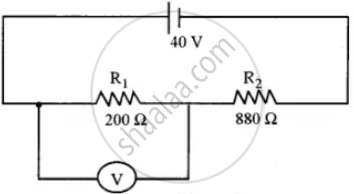
When the balance point is obtained in the potentiometer, a current is drawn from ______.
How is potential gradient measured? Explain.
What are the disadvantages of a potentiometer?
Describe how a potentiometer is used to compare the EMFs of two cells by connecting the cells individually.
Describe with the help of a neat circuit diagram how you will determine the internal resistance of a cell by using a potentiometer. Derive the necessary formula.
A potentiometer wire has a length of 1.5 m and a resistance of 10 Ω. It is connected in series with the cell of emf 4 Volt and internal resistance 5 Ω. Calculate the potential drop per centimeter of the wire.
What will be the effect on the position of zero deflection if only the current flowing through the potentiometer wire is decreased?
Describe how a potentiometer is used to compare the emf's of two cells by the combination method.
Why is a potentiometer preferred over a voltmeter for measuring emf?
The emf of a cell is balanced by a length of 120 cm of a potentiometer wire. When the cell is shunted by a resistance of 10 Ω, the balancing length is reduced by 20 cm. Find the internal resistance of the cell.
If the potential gradient of a wire decreases, then its length ______
The instrument which can measure terminal potential difference as well as electromotive force (emf) is ______
State any one use of a potentiometer.
A voltmeter has a resistance of 100 Ω. What will be its reading when it is connected across a cell of emf 6 V and internal resistance 20 Ω?
The resistivity of potentiometer wire is 40 × 10-8 ohm - metre and its area of cross-section is 8 × 10-6 m2. If 0.2 ampere current is flowing through the wire, the potential gradient of the wire is ______.
Which of the following is true for a potentiometer?
A potentiometer wire is 10 m long and has resistance of 2`Omega`/m. It is connected in series with a battery of e.m.f 3 V and a resistance of 10 `Omega`. The potential gradient along the wire in V/m is ______.
In the potentiometer experiment, the balancing length with cell E1 of unknown e.m.f. is ℓ1 cm. By shunting the cell E1 with resistance 'R' which is equal to internal resistance (r) of the cell E1, the balancing length ℓ2 is ______
A potentiometer is used to measure the potential difference between A and B, the null point is obtained at 0.9 m. Now the potential difference between A and C is measured, the null point is obtained at 0.3 m. The ratio `E_2/E_1` is (E1 > E2) ______

The current drawn from the battery in the given network is ______
(Internal resistance of the battery is neglected)

In the experiment to determine the internal resistance of a cell (E1) using a potentiometer, the resistance drawn from the resistance box is 'R'. The potential difference across the balancing length of the wire is equal to the terminal potential difference (V) of the cell. The value of internal resistance (r) of the cell is ______
A potentiometer wire has a length of 4m and resistance of 5Ω. It is connected in series with 495 Ω resistance and a cell of e.m.f. 4V. The potential gradient along the wire is ______
If the length of potentiometer wire is increased, then the length of the previously obtained balance point will ______.
Two students X and Y perform potentiometer experiment separately and null point was obtained as shown in diagram. During the experiment, ______.
- X increases the value of R (resistance)
- Y decreases the value of S (resistance)
The position of null point obtained by students X and Y respectively.
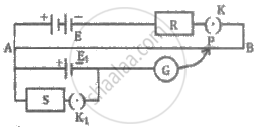
A student connected the circuit as shown in the figure to determine the internal resistance of a cell E1 by potentiometer (E > E1). He is unable to obtain the null point because ______.
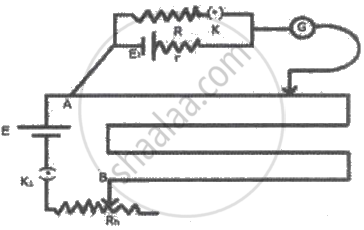
In a potentiometer experiment when three cells A, B, C are connected in series the balancing length is found to be 740 cm. If A and B are connected in series, the balancing length is 440 cm and when B and C are connected in series, it is 540 cm. The e.m.f. of A, B, and C cells EA, EB, EC are respectively (in volt) ______
A battery is connected with a potentiometer wire. The internal resistance of the battery is negligible. If the length of the potentiometer wire of the same material and radius is doubled then ______.
A potentiometer wire is 100 cm long and a constant potential difference is maintained across it. Two cells are connected in series first to support one another and then in opposite direction. The balance points are obtained at 50 cm and 10 cm from the positive end of the wire in the two cases. The ratio of emf's is ______.
In the experiment of potentiometer, at balance point, there is no current in the ______.
AB is a wire of potentiometer with the increase in the value of resistance R, the shift in the balance point J will be ______.
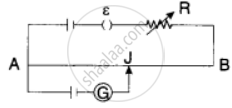
The best instrument for accurate measurement of EMF of a cell is ____________.
A 10 m long wire of uniform cross-section and 20 Ω resistance is used in a potentiometer. The wire is connected in series with a battery of 5 V along with an external resistance of 480 Ω. If an unknown emf E is balanced at 6.0 m length of the wire, then the value of unknown emf is ______.
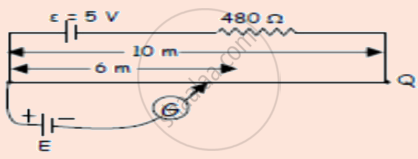
AB is a wire of potentiometer with the increase in value of resistance R, the shift in the balance point J will be:

What is the current I in the circuit as show in fig.
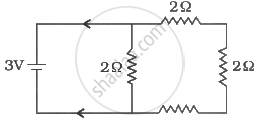
The instrument among the following which measures the e.m.f of a cell most accurately is ______
In an experiment with a potentiometer, VB = 10V. R is adjusted to be 50Ω (Figure). A student wanting to measure voltage E1 of a battery (approx. 8V) finds no null point possible. He then diminishes R to 10Ω and is able to locate the null point on the last (4th) segment of the potentiometer. Find the resistance of the potentiometer wire and potential drop per unit length across the wire in the second case.
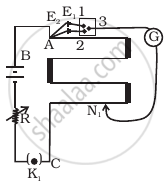
A Daniel cell is balanced on 125 cm lengths of a potentiometer wire. Now the cell is short circuited by a resistance 2 Ω and the balance is obtained at 100 cm. The internal resistance of the Daniel cell is ______.
As a cell age, its internal resistance increases. A voltmeter of resistance 270 Ω connected across an old dry cell reads 1.44 V. However, a potentiometer at the balance point gives a voltage measurement of the cell as 1.5 V. Internal resistance of the cell is ______ Ω.
The emf of the cell of internal resistance 1.275 Ω balances against a length of 217 cm of a potentiometer wire. Find the balancing length when the cell is shunted by a resistance of 15 Ω.
What should be the diameter of a soap bubble such that the excess pressure inside it is 51.2 Pa? [Surface tension of soap solution = 3.2 × 10−2 N/m]
Draw neat labelled diagram of potentiometer as voltage divider.
The Figure below shows a potentiometer circuit in which the driver cell D has an emf of 6 V and internal resistance of 2 Ω. The potentiometer wire AB is 10 m long and has a resistance of 28 Ω. The series resistance RS is of 2 Ω.
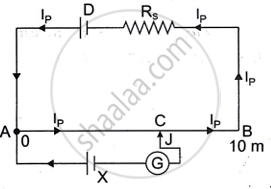
- The current Ip flowing in the potentiometer wire AB when the jockey (J) does not touch the wire AB.
- emf of the cell X if the balancing length AC is 4.5 m.
